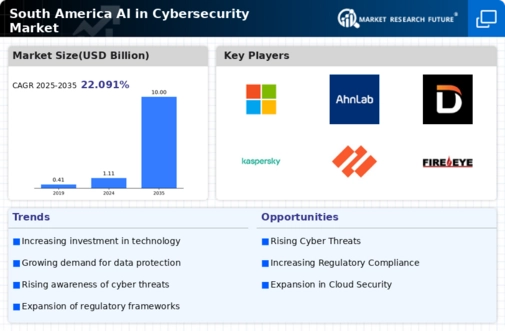Collaboration Among Stakeholders
Collaboration among various stakeholders, including government agencies, private sector companies, and academic institutions, is emerging as a vital driver for the ai in-cybersecurity market in South America. This collaborative approach fosters knowledge sharing, innovation, and the development of comprehensive cybersecurity strategies. Initiatives aimed at enhancing cybersecurity resilience are gaining traction, with stakeholders recognizing the importance of a unified response to cyber threats. The ai in-cybersecurity market is likely to see increased investment as partnerships facilitate the development of cutting-edge AI solutions tailored to regional challenges. Furthermore, collaborative efforts can lead to the establishment of best practices and standards, enhancing the overall security posture of organizations. As stakeholders work together to address cybersecurity challenges, the demand for AI-driven solutions is expected to rise, reflecting the collective commitment to safeguarding digital assets.
Increasing Digital Transformation
The rapid pace of digital transformation across various sectors in South America is a primary driver for the ai in-cybersecurity market. As organizations increasingly adopt cloud computing, IoT devices, and mobile technologies, the attack surface for cyber threats expands significantly. This transformation necessitates advanced security measures, leading to a projected growth of the ai in-cybersecurity market by approximately 25% annually. Companies are investing in AI-driven solutions to enhance their security posture, automate threat detection, and respond to incidents more effectively. The integration of AI technologies allows for real-time analysis of vast amounts of data, enabling organizations to identify vulnerabilities and mitigate risks proactively. Consequently, the demand for sophisticated ai in-cybersecurity solutions is expected to rise, reflecting the urgency of securing digital assets in an increasingly interconnected environment.
Evolving Cybersecurity Regulations
The evolving landscape of cybersecurity regulations in South America significantly influences the ai in-cybersecurity market. Governments are implementing stricter data protection laws and compliance requirements, compelling organizations to adopt advanced security measures. For instance, the introduction of regulations similar to the GDPR in Europe has prompted businesses to invest in ai-driven cybersecurity solutions to ensure compliance and avoid hefty fines. The ai in-cybersecurity market is projected to grow by 20% as organizations seek to align their security frameworks with regulatory standards. This regulatory pressure not only drives investment in AI technologies but also fosters innovation in developing solutions that can adapt to changing compliance landscapes. As organizations strive to meet these requirements, the demand for ai in-cybersecurity solutions is likely to increase, highlighting the critical role of AI in achieving compliance and enhancing overall security.
Rising Awareness of Cybersecurity Risks
The growing awareness of cybersecurity risks among businesses and consumers in South America serves as a crucial driver for the ai in-cybersecurity market. High-profile cyber incidents have heightened concerns about data breaches and identity theft, prompting organizations to prioritize cybersecurity investments. Surveys indicate that over 70% of companies in the region recognize the need for enhanced security measures, leading to increased adoption of AI-driven solutions. The ai in-cybersecurity market is expected to experience a growth rate of 30% as organizations seek to leverage AI technologies for threat detection and response. This heightened awareness not only drives demand for advanced security solutions but also encourages collaboration between public and private sectors to address cybersecurity challenges. As businesses strive to protect sensitive information, the role of AI in enhancing cybersecurity measures becomes increasingly vital.
Investment in Cybersecurity Infrastructure
Investment in cybersecurity infrastructure is a significant driver for the ai in-cybersecurity market in South America. Organizations are allocating substantial budgets to enhance their security frameworks, recognizing the importance of robust cybersecurity measures in safeguarding their operations. Reports indicate that spending on cybersecurity solutions in the region is projected to reach $10 billion by 2026, with a considerable portion directed towards AI-driven technologies. This investment trend reflects a growing understanding of the need for proactive security measures, as traditional approaches may no longer suffice against sophisticated cyber threats. The ai in-cybersecurity market is likely to benefit from this influx of capital, as organizations seek to implement advanced AI solutions for threat intelligence, incident response, and risk management. As the cybersecurity landscape evolves, the emphasis on infrastructure investment will continue to shape the market dynamics.


















Leave a Comment